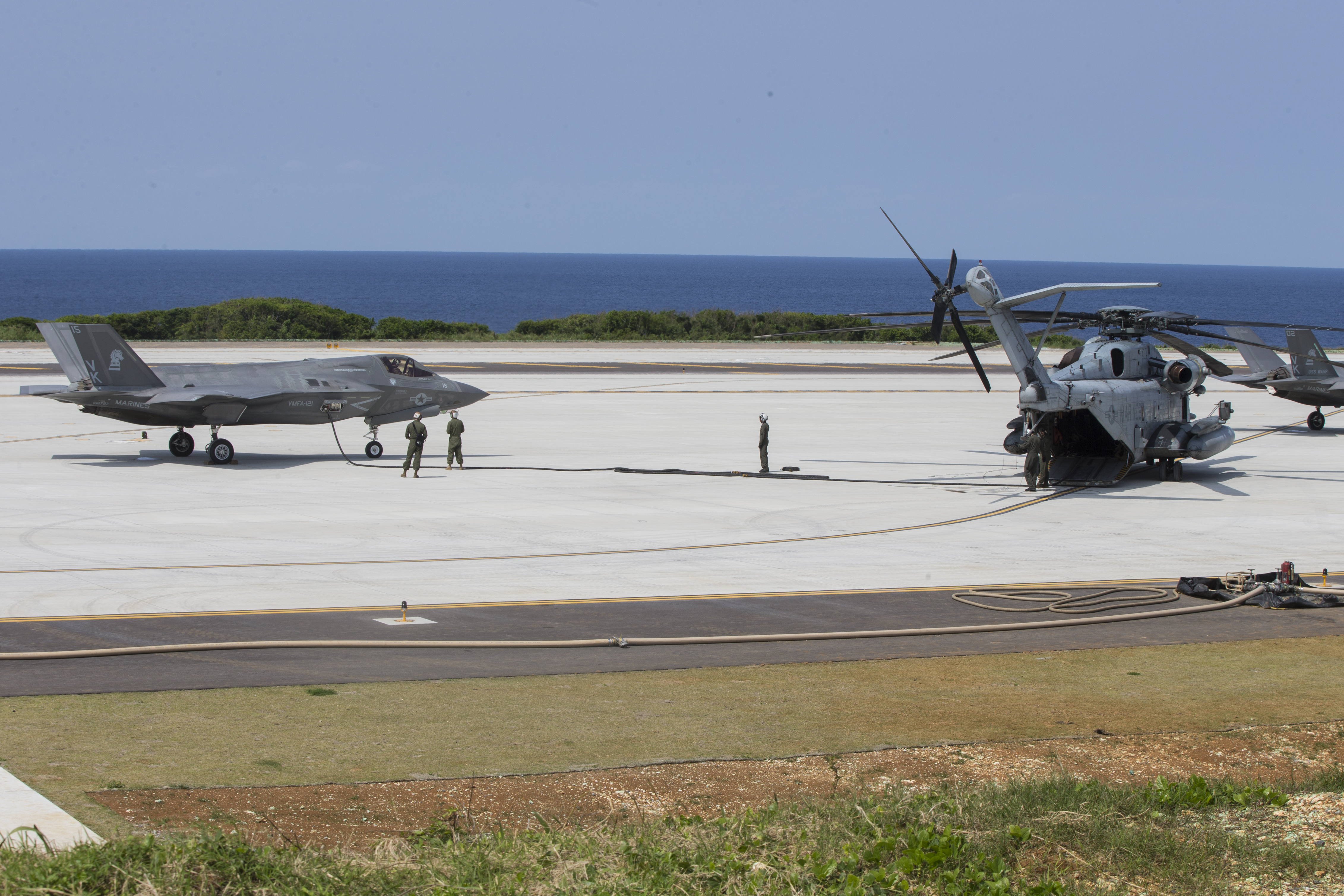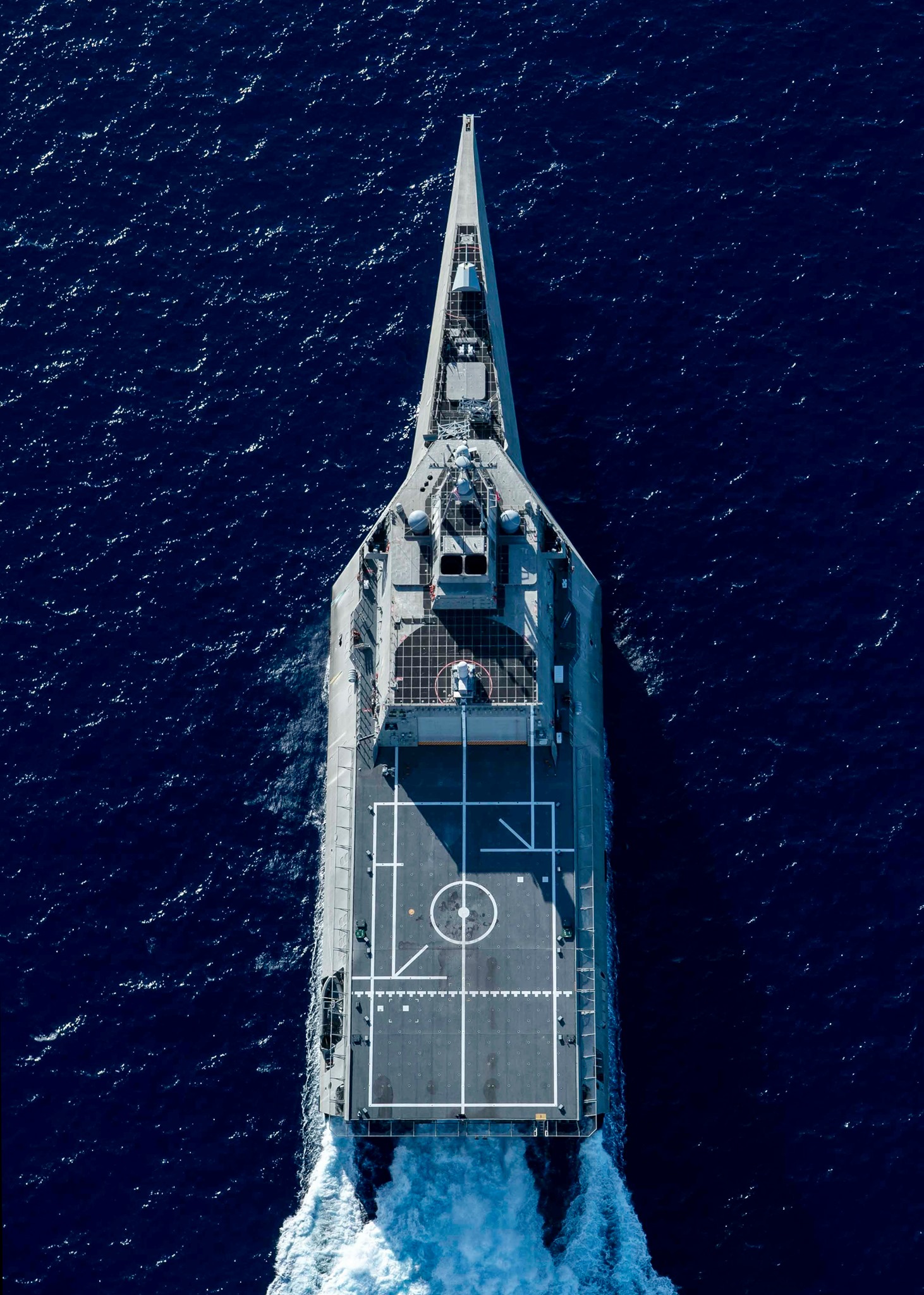ABOARD THE LITTORAL COMBAT SHIP USS KANSAS CITY, OFF THE COAST OF CALIFORNIA – The cavernous mission bay of USS Kansas City (LCS-22) was crafted to hold the Navy’s needs to find sea mines, fight swarm boats or interdict submarines – mission packages that have lagged the construction of the ships and plagued the Littoral Combat Ship program.
Now the LCS might be ready for a new mission – moving Marines across the Indo-Pacific.
As the U.S. Navy navigates a new era of strategic competition with China in a constrained fiscal environment, the service could turn to one of its pained ship programs to help perform the Marines Corps’ Expeditionary Advanced Based Operations (EABO) island-hopping campaign in the Pacific.
The Navy is considering the viability of using the Independence-class variant that is headed to the Pacific to move Marines around islands and archipelagos for EABO. Instead of containers filled with mission gear, Marines could pack into the mission bay below the flight deck of ships like Kansas City, as they head to islands to set up bases where they could fire anti-ship missiles.
“We’ve done EABO – the Expeditionary Advanced Basing Operations – just moving Marines and all that around. I mean, it’s not a new concept for the Navy. It’s just leveraging this platform to do it,” Rear Adm. Robert Nowakowski, the deputy commander of Navy Recruiting Command and Naval Education and Training Command Force Development who is currently leading a new effort called Task Force LCS, told reporters last month.
EABO, the radical rethinking of how the Marines will deploy in the near future, is predicated on small groups ranging across the Pacific islands, creating ad hoc bases and expeditionary nodes.
For example, the Marines have tested using MV-22B tilt rotors and KC-130s to build remote bases to refuel and rearm F-35B fighters. The Marines are also experimenting with a modified Joint Light Tactical Vehicle to lob anti-ship missiles from shore in a program known as NMESIS. The idea is to rely less on the Navy’s massive amphibious ships and more on air and smaller platforms and units to spread Marines around islands and shorelines.

An F-35B Lightning II fighter aircraft with Marine Fighter Attack Squadron 121 refuels at an established Forward Arming and Refueling Point during simulated Expeditionary Advanced Base Operations at Ie Shima Training Facility, March 14, 2019. Marines with the 31st Marine Expeditionary Unit are conducting simulated EABO in a series of dynamic training events to refine their ability to plan, rehearse and complete a variety of missions. US Marine Corps photo
To that end, analysts and observers say the Navy should experiment with the concept of using the LCS to move Marines around the island chains, but note there are several limitations as to what the ship can do because of its size and design.
For example, the Independence-class boat launch is more than a dozen feet from the waterline and would require pier access to unload Marines and equipment.
The idea comes as the Navy looks for ways to employ the Littoral Combat Ships – which are now entering the fleet in high numbers – and the Marine Corps pursues a Light Amphibious Warship to shuttle Marines around the island chains. The Navy has struggled with the LCS mission packages – envisioned as a way to swap three different types of mission sets within the ship. But the service has only deployed an LCS with a version of the surface warfare mission package, as developing and fielding the anti-submarine warfare and mine countermeasure packages has been delayed.
“The LCS – the mission is not completely clear. And so I think the Navy is looking at this as a way to provide an additional mission for the LCS to do,” Hudson Institute senior fellow Bryan Clark, a former submariner who previously worked on the chief of naval operations staff, told USNI News.
“It would help the Navy get more value out of the LCS and make those deployments more impactful,” Clark added. “And then it would help them on the financial side because it would give them a way to mitigate that the LAW may be slow in coming or may not ever come at all.”
While the possibility of using the LCS to move Marines around the littorals is not new, the recent shift to a strategy focused on countering China and the Marine Corps’ emphasis on new operating concepts like EABO and Littoral Operations in a Contested Environment (LOCE) brings new urgency to an idea that has percolated throughout the Navy for years.
‘These Ships Are Fast’

USS Tulsa (LCS 16) conducts routine operations in the Philippine Sea on June 13, 2021. US Navy Photo
The idea of using the LCS to pitch in for EABO specifically applies to the Independence-variant, which has a large mission bay that experts say could house Marines. The Indy-class ships are also heading to the Pacific region and receiving priority for the Naval Strike Missile. Several Independence-class ships have deployed to the Indo-Pacific in the last year.
During a recent USNI News visit aboard Kansas City, Nowakowski touted the speed of the LCS – more than 40 knots – as one of its attributes that could help with the Marine Corps mission.
“I mean these ships are fast. And one of the options is to use these ships to transport between the island chain. Now, if you have missiles on these island chains and you have ships moving people between the island chain, that’s a whole other element of surprise, a whole other strategy, that throws a curveball to our adversary,” Nowakowski said.
“How do they know what we have specifically? We’re going to have stuff on the ships, but we’re also going to have stuff on the land. And we’re moving people around all the time – it’s hard for them to counter it,” he added. “And if they do counter it, they have to have more forces in order to counter it. So it just adds a whole other level of complexity and lethality to our national security.”
Bob Work, a former deputy secretary of defense and undersecretary of the Navy, said the Marine Corps could begin by experimenting with an Independence-class variant at Camp Pendleton, Calif., to get a better sense of how many Marines it could fit in the 338,000 cubic foot mission bay, what kind of housing equipment would be required, and how the Marines would conduct landing operations.
“Is it a reinforced company? Is it just a couple of platoons? What would it be? And they would practice loading it. They would practice sending the Marines out to sea for periods of time to make sure the ship would be able to support them,” Work, who is also the chair of the board of the U.S. Naval Institute, told USNI News.
“You start slow. You figure out how to make the platform and the Marines work together. Then, you take it to an exercise and demonstrate the capability,” he added. “And as soon as you’re satisfied that the capability is a good one, you go from exercise to operational deployment. So to me, this would not be a hard thing to do.”











No comments:
Post a Comment
How did you like the post, leave a comment. I would appreciate hearing from you all. Best wishes from JC's Naval, Maritime and Military News